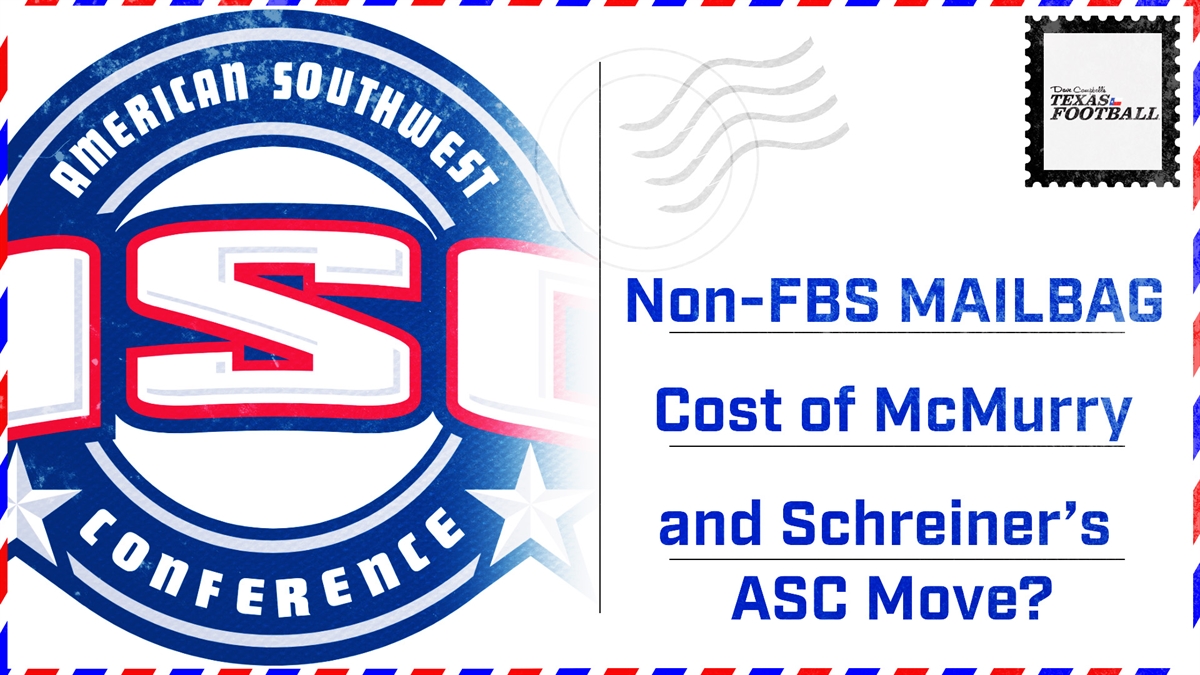I was a big fan of the World Wrestling Foundation in my younger days. I fondly recall sitting on the wooden bleachers inside D.L. Ligon Coliseum on the campus of Midwestern State, extending my thumbs up high in the air as Hacksaw Jim Duggan entered the ring carrying his giant American Flag and yelling, “Hooooooo!”
That memory entered my mind when I received news that McMurry and Schreiner were returning to the American Southwest Conference last week because of another famous saying by a former WWF superstar, Million Dollar Man Ted DiBiase, who routinely reminded everyone that “every man has a price” during his interviews.
Regardless of how much we wish it didn’t, that phrase still rings true. This is why the first question I received via text and a question I posed to many across the ASC was about the rumored financial package offered by the ASC.
That was one of many questions I received from readers and industry observers during the first 48 hours after the announcement. Here are the answers to the most pertinent questions.
How much money is in the deal?
I have heard a wide range of numbers from multiple sources, ranging from $4 million to $7 million for McMurry and Schreiner. The most consistent numbers I’ve received indicate that each school will receive $4 to $4.5 million. To be clear, these numbers are my best guess and have not been confirmed.
The ‘Baptist 4’ were desperate to keep the ASC together and felt that paying schools to join was the only option after discussions with every other NCAA Division III conference in the country ultimately proved fruitless. Ultimately, the four schools felt that paying other DIII institutions was a better financial option than being a DIII independent or moving to Division II or FCS.
Is there a buyout in the agreement between the ASC and the SCAC?
This is a fantastic question. The ASC announced that each school in the newly reformed ASC signed a ten-year agreement. However, since the ASC began in 1996, the ASC and SCAC have undergone multiple realignments. Only East Texas Baptist, Hardin-Simmons, Howard Payne, and Mary Hardin-Baylor have remained in the same conference since 1996. It’s safe to say the ‘Baptist 4’ have formed a solid bond and have remained loyal to each other through multiple times of uncertainty.
As for a buyout, I have not received confirmation on a potential buyout in the agreement. Some schools have instructed their personnel to refer everyone to the university’s communications office, while some sources said only the university presidents can answer this question. Is that an indication of a buyout included, or did the ASC secure an automatic bid for at least the next 10 years? Only time will tell.
Did the ASC start a trend of conferences paying teams to join?
To my knowledge, this is the first time a DIII conference has paid another school to join. I’m pretty sure it hasn’t happened in Division II either, but nothing would surprise me in Division I. The fallout from this agreement could be substantial. How much money will another school demand to join the ASC in the future? After all, you’ve established a precedent.
If conferences paying schools to join becomes routine, the conferences and schools will remain in a continuous state of transition. Do you think realignment is crazy now? It can and might get worse if every move comes down to the highest bidder. The ASC might be a trendsetter once again.
Where should McMurry and Schreiner spend the money?
Unlike Division I, the cost for an institution to move from one conference to another isn’t substantial. According to sources, McMurry and Schreiner only owe the SCAC dues through the 2026-2027 academic year. In other words, very little money the universities receive will be used to exit the SCAC.
It will not surprise you that I believe the money should go toward athletics. It doesn’t necessarily need to be the football program, but it needs to benefit the student-athletes. Let’s acknowledge that the move was made for athletics, not academics. While the money wouldn’t guarantee a conference title, it could close the gap between the War Hawks and Mountaineers and the rest of the ASC.
What does the LSC do now?
The Lone Star Conference undoubtedly wished to be the landing place for UMHB and HSU, even though they understood it was always unlikely. Despite the disappointment, nothing has changed for the LSC. It remains a solid DII conference that needs to avoid another disastrous alliance with Central Washington and Western Oregon, which has placed a massive hole in the budgets of every football university in the conference.
What options exist for the SCAC to be eligible for an automatic bid?
The worst part about McMurry and Schreiner rejoining the ASC is that it left the SCAC with only five teams following the 2025 campaign, which could keep the conference from obtaining an automatic bid to the DIII playoffs. The good news for SCAC Commissioner Dwayne Hanberry is that McMurry and Schreiner will be conference members for the 2025 season. The two-year clock to earn an automatic bid to the playoffs will begin this year since the conference will have six playoff-eligible teams with the addition of Hendrix.
Hanberry only needs to add one school before the 2026 season to have an automatic bid for the playoffs in 2027. Sources pointed to Belhaven and Huntingdon as potential targets. Both currently reside in the USA South, with nine members sponsoring football. Who knows? The SCAC may follow the ASC’s lead and create a financial package to entice someone to join if an automatic bid to the playoffs holds that much value for the conference.
Will the ASC add more schools?
Of course, the ASC will consider adding more schools to help stabilize the conference for the long term. However, the issue for them will be finding a school that will compete yearly against UMHB and HSU without a significant financial incentive. One thing for sure is the price won’t go down from the baseline they set with this agreement.
This article is available to our Digital Subscribers.
Click "Subscribe Now" to see a list of subscription offers.
Already a Subscriber? Sign In to access this content.


